.gif)
Cowl (oast)
Encyclopedia
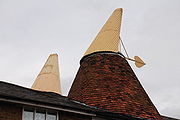
Kiln
A kiln is a thermally insulated chamber, or oven, in which a controlled temperature regime is produced. Uses include the hardening, burning or drying of materials...
to keep the weather out of, and induce a flow of air through, the kiln. They are normally associated with oasts but can also be found on breweries (Letheringsett
Letheringsett
Letheringsett is a village in the English county of Norfolk. It forms part of the civil parish of Letheringsett with Glanford, along with the hamlet of Glandford. The village straddles the A148 King’s Lynn to Cromer road. Letheringsett is 1.2 miles west of Holt, 32.2 west north east of King’s Lynn...
, Norfolk), maltings (Ware, Herts; Hadlow
Hadlow
Hadlow is a village in the Medway valley, near Tonbridge, Kent; it is in the Tonbridge and Malling district. The Saxon name for the settlement was Haeselholte...
, Kent) and watermills (East Linton
East Linton
East Linton is a town in East Lothian, Scotland, situated on the River Tyne and A199 road five miles east of Haddington, with a population of 1,774...
, East Lothian).
Construction
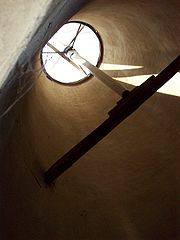
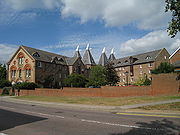
Gudgeon
A gudgeon is a circular fitting, often made of metal, which is affixed to a surface. It allows for the pivoting of another fixture. It is generally used with a pintle, which is a pin which pivots in the hole in the gudgeon. As such, a gudgeon is a simple bearing.-Winged gudgeons:A winged gudgeon...
on the bottom of the centre post sits in. At the top of the kiln, the centre post passes through a two or three armed top stay iron. At the top of the centre post is carried the back board which carries an elm
Elm
Elms are deciduous and semi-deciduous trees comprising the genus Ulmus in the plant family Ulmaceae. The dozens of species are found in temperate and tropical-montane regions of North America and Eurasia, ranging southward into Indonesia. Elms are components of many kinds of natural forests...
curb ring at the bottom, and one or two curb rings higher up on all except the smallest of cowls. A tie beam could also be carried, either at each curb level, or just the bottom curb level, spanning the width of the cowl. The top of the backboard carries a shaped top plate to which the weatherboards were affixed. The whole is covered in tapered weatherboards
Weatherboarding
Weatherboarding is the cladding or ‘siding’ of a house consisting of long thin timber boards that overlap one another, either vertically or horizontally on the outside of the wall. They are usually of rectangular section with parallel sides...
, widest at the bottom and narrowest at the top. Slotted through the centre post and attached to the back board is the distinctive finger which sometimes carried a motif. The finger assisted the turning of the cowl in light winds. Weatherboards would be attached to the cowl with nails made from copper
Copper
Copper is a chemical element with the symbol Cu and atomic number 29. It is a ductile metal with very high thermal and electrical conductivity. Pure copper is soft and malleable; an exposed surface has a reddish-orange tarnish...
. Cowls were usually painted white, although some were cream. The cowl is constructed so that when looking down vertically on a kiln, it covers the whole of the opening. It also covers some ⅔ to ¾ of the circumference
Circumference
The circumference is the distance around a closed curve. Circumference is a special perimeter.-Circumference of a circle:The circumference of a circle is the length around it....
of the kiln opening, the remaining section being open to allow air to vent from the kiln. An illustration of a cowl and the cross-section of a kiln can be seen here.
The size of cowls is expressed as height from top plate to base by width of kiln opening covered. Cowls varied in size from 7' by 5' (2.13 by 1.52 m) to 24' by 15' (7.32 by 4.57 m).
How does it work?
The cowl always has its back into the windWind
Wind is the flow of gases on a large scale. On Earth, wind consists of the bulk movement of air. In outer space, solar wind is the movement of gases or charged particles from the sun through space, while planetary wind is the outgassing of light chemical elements from a planet's atmosphere into space...
, with the finger pointing in the direction toward which the wind is blowing. As the wind blows past the cowl, it creates a low pressure
Pressure
Pressure is the force per unit area applied in a direction perpendicular to the surface of an object. Gauge pressure is the pressure relative to the local atmospheric or ambient pressure.- Definition :...
area inside the edge boards of the cowl. In the bottom of the kiln are various openings; with these open, a flow of air through the kiln is created, added to which is the heated air when a kiln is in use rising
Convection
Convection is the movement of molecules within fluids and rheids. It cannot take place in solids, since neither bulk current flows nor significant diffusion can take place in solids....
naturally as it is less dense
Density
The mass density or density of a material is defined as its mass per unit volume. The symbol most often used for density is ρ . In some cases , density is also defined as its weight per unit volume; although, this quantity is more properly called specific weight...
than cold air.
Removal and repair
The building and maintenance of cowls was generally the job of a wheelwrightWheelwright
A wheelwright is a person who builds or repairs wheels. The word is the combination of "wheel" and the archaic word "wright", which comes from the Old English word "wryhta", meaning a worker or maker...
. To remove a cowl, a cowl pole would be bolted to one of the main beams of the kiln, and the top would protrude from the top of the kiln. A rope
Rope
A rope is a length of fibres, twisted or braided together to improve strength for pulling and connecting. It has tensile strength but is too flexible to provide compressive strength...
would be passed over the pulley
Pulley
A pulley, also called a sheave or a drum, is a mechanism composed of a wheel on an axle or shaft that may have a groove between two flanges around its circumference. A rope, cable, belt, or chain usually runs over the wheel and inside the groove, if present...
at the top of the cowl pole and tied around the cowl. The finger would be removed, and the coach bolt securing the centre post to the backboard undone. The cowl could then be lifted off the tenon
Mortise and tenon
The mortise and tenon joint has been used for thousands of years by woodworkers around the world to join pieces of wood, mainly when the adjoining pieces connect at an angle of 90°. In its basic form it is both simple and strong. Although there are many joint variations, the basic mortise and tenon...
at the top of the centre post and lowered down the kiln. Ropes were also tied at each end of the tie beam if present. The cowl could either be lowered inverted, or alternatively, a ladder
Ladder
A ladder is a vertical or inclined set of rungs or steps. There are two types: rigid ladders that can be leaned against a vertical surface such as a wall, and rope ladders that are hung from the top. The vertical members of a rigid ladder are called stringers or stiles . Rigid ladders are usually...
would be placed against the kiln roof and the cowl be carried down by the wheelwright. The weight being mainly taken by those in the kiln working on the rope. It was important to avoid damaging the kiln roof. Replacement was a reversal of the above process. A series of illustrations showing the process can be found here.The modern method involves using a mobile crane.
Sussex type
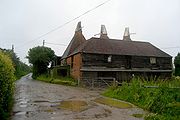
West Midlands
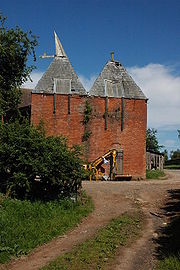
Other cowls

The Richard Rogers
Richard Rogers
Richard George Rogers, Baron Rogers of Riverside CH Kt FRIBA FCSD is a British architect noted for his modernist and functionalist designs....
designed National Assembly Building
Senedd
The Senedd , also known as the National Assembly building, houses the debating chamber and three committee rooms for the National Assembly for Wales in Cardiff. The Senedd building was opened by Queen Elizabeth II on 1 March 2006 and the total cost was £69.6 million, which included £49.7M in...
in Cardiff
Cardiff
Cardiff is the capital, largest city and most populous county of Wales and the 10th largest city in the United Kingdom. The city is Wales' chief commercial centre, the base for most national cultural and sporting institutions, the Welsh national media, and the seat of the National Assembly for...
features a six-metre-high purpose built rotating wind cowl providing ventilation to the debating chamber. The design was inspired by traditional oast houses.
External links
- Gallery of oast cowls
- Dude & Arnette Makers of cowls.
- Castle Mouldings Makers of cowls in fibreglass.

